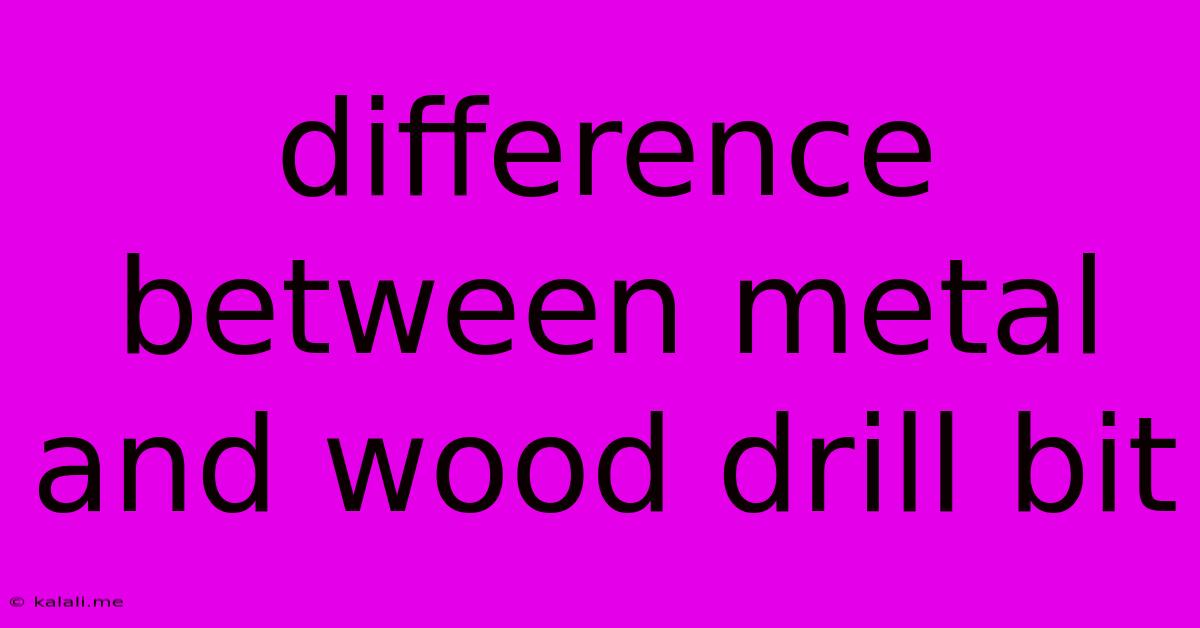Difference Between Metal And Wood Drill Bit
Kalali
May 25, 2025 · 3 min read

Table of Contents
Metal vs. Wood Drill Bits: A Comprehensive Guide
Choosing the right drill bit is crucial for a successful project, whether you're crafting intricate wooden toys or drilling precise holes in metal sheets. This guide will delve into the key differences between metal and wood drill bits, helping you select the perfect tool for the job and avoid costly mistakes. Understanding these differences will ensure clean, accurate holes every time, protecting your materials and enhancing your project's overall quality.
Understanding the Core Differences: Material and Design
The most significant difference lies in their design and the materials they're made from. These variations directly impact their cutting ability and longevity when used on different materials.
Wood Drill Bits:
- Material: Typically made from high-speed steel (HSS), sometimes with a titanium nitride (TiN) coating for increased durability and reduced friction. Less expensive options may be made from carbon steel.
- Design: Feature a pointed tip and long, sharp flutes designed to easily cut through wood fibers. The flutes effectively clear wood chips, preventing clogging and overheating. They often have a spiral point, which helps to center the bit and create clean entry holes. Types include brad point bits, twist bits, and forstner bits, each suited for specific tasks within woodworking.
- Cutting Action: Wood drill bits cut the material, using sharp edges to shear the wood fibers.
Metal Drill Bits:
- Material: Almost always made from high-speed steel (HSS), often with a cobalt alloy addition (HSS-Co) for increased hardness and durability, particularly when working with tougher metals. Titanium nitride (TiN) and titanium aluminum nitride (TiAlN) coatings are also common for improved performance.
- Design: Feature a sharper point angle and shorter, more robust flutes than wood drill bits. The flutes are designed to effectively remove metal shavings, which are much harder and tougher than wood chips. The point is crucial for accurate starting and preventing the bit from walking or slipping. Different types of metal drill bits exist (e.g., high-speed steel, cobalt steel, titanium coated) depending on the intended material and hardness.
- Cutting Action: Metal drill bits shear the material, relying on their strength and hardness to displace the metal.
Key Differences Summarized:
| Feature | Wood Drill Bit | Metal Drill Bit |
|---|---|---|
| Material | HSS, sometimes TiN coated | HSS, often HSS-Co, TiN or TiAlN coated |
| Point Angle | Wider | Sharper |
| Flutes | Long, wide | Shorter, narrower |
| Cutting Action | Cuts | Shears |
| Chip Removal | Designed for wood chips | Designed for metal shavings |
| Durability | Moderate | High |
Choosing the Right Drill Bit: Application Matters
Using the wrong drill bit can lead to broken bits, damaged materials, and inaccurate holes. Always match the bit to the material:
- Wood: Use a wood drill bit designed for the type of wood you're working with. Brad point bits are excellent for precise, clean holes in hardwoods. Twist bits are versatile and suitable for various applications. Forstner bits create flat-bottomed holes.
- Metal: Use a metal drill bit specifically designed for the type of metal. Cobalt steel bits are ideal for harder metals like stainless steel. High-speed steel bits are suitable for softer metals like aluminum or brass.
By understanding the key differences between wood and metal drill bits, you'll be equipped to select the appropriate tool for any drilling project, ensuring accuracy, efficiency, and a higher quality outcome. Remember, selecting the correct drill bit is an investment in both your tools and your project's success.
Latest Posts
Latest Posts
-
No Matching Key Exchange Method Found Their Offer Diffie Hellman Group1 Sha1
May 25, 2025
-
The World You Were Born In No Longer Exists
May 25, 2025
-
My Name Is A Killing Word
May 25, 2025
-
Light Switch Has 2 Black Wires And 1 Red
May 25, 2025
-
Filling In Holes In Concrete Floor
May 25, 2025
Related Post
Thank you for visiting our website which covers about Difference Between Metal And Wood Drill Bit . We hope the information provided has been useful to you. Feel free to contact us if you have any questions or need further assistance. See you next time and don't miss to bookmark.